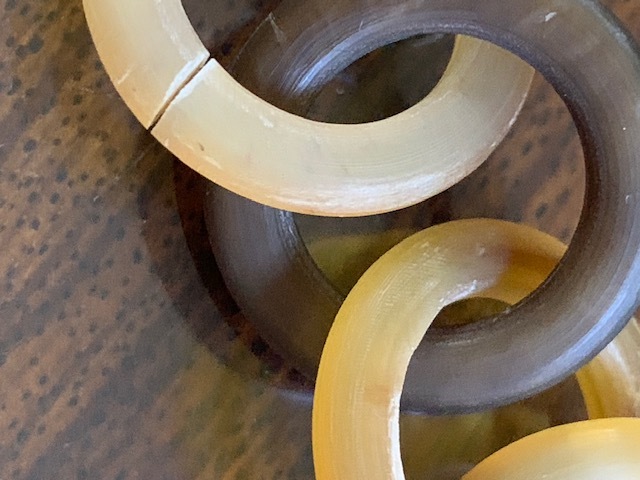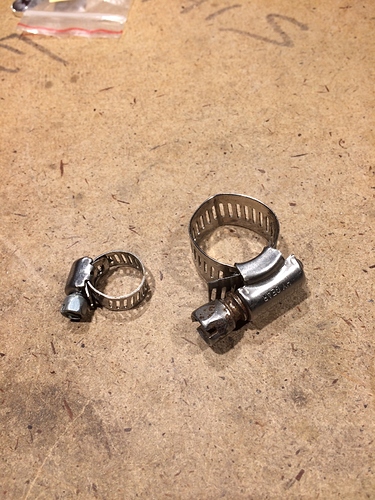Hi, I’m new to the forum and am trying to find out what type of clamp can be used to hold a bone ring-shape (approx. 23mm OD) closed while it is curing from use of an epoxy. I have many to do so will need quite a few clamps so they can’t be really expensive.
Thank the community, in advance, for any help you can provide.
Greetings
Can you supply a photo? I am not sure what you are trying to do.
Don Meixner
I use many different sizes of C-clamps for all sorts of unexpected things, and I think this small one would work for your project: https://www.harborfreight.com/2-inch-industrial-c-clamp-37844.html
I would use something soft, such as a piece of leather, to protect the bone ring while it’s held in the metal clamp.

Hi Don - these are horn rings that I need to glue and clamp for a tight fit. Have many so can’t do one at a time. Any ideas?
Maybe some stout rubber bands? If you were to use the ones from broccoli, or other veg, which are wide, and maybe wrapped it a few times it may grip and hold tight enough.
Perhaps the rings are much smaller than I think -and if so this would not work well.
Hi Lucy,
What’s the diameter?
Pam
Small spring clamps would probably do fine. These ones seem to have wide plastic jaws, which shouldn’t mar your rings.
have actually been using some heavy duty rubber bands but they still don’t have the force needed to close the ring tightly - thanks for the suggestion though
Have tried the spring clamp you speak of but given the rings have rounded edges the clamp can’t get a good grasp and the rings slip out.
HMMM - thought, at first, these wouldn’t work at all BUT may be able to work with this and the pads that are available with them. Will make a trip to HF tomorrow!
HI Pam
The OD is 23mm. I’m going to try the C-clamp that Betty2 suggested, as I might be able to make some adjustments to make it work. That said, if you think you have a better suggestion, I’m all ears.
THANKS to ALL who have offered suggestions so far. I appreciate everyone’s help. So glad I joined the group!
The wide rubber band is a good start as it would cushion the surface for what I suggest next. Get some cheap wire from a place like home depot. Over the top of the rubber band put a loose circle of wire that you twisted into a circle and cut off the extra. Now in a section that doesnt have the portion you twisted together put a small rod even a small nail into it then twist it like winding a clock. It will tighten the wire to the exact amount you want it to. We’ve all done this on the outside of charcoal blocks to keep them from breaking. The rubber band under heath the wire helps to keep the surface from being marred. Hope this makes sense. Have a migraine and the meds make me think jumbled.
Aggie
Its a little weird, but what about elastic castration tool and bands? If you’re in a rural area, you can probably find them at a farm and ranch store, otherwise here is one on Amazon…
I have no experience with them, but from a quick search they are available in different diameters, which should (in theory) translate to different amounts of compression.
Brian, who enjoys misusing tools from other trades
Look again at the spring clamps I posted. Spring clamps are much quicker to use than c-clamps, and the ones I posted have plastic pads at the jaws so you could easily adapt them to hold the rings without slipping. Since the rings are very nearly closed it shouldn’t take much pressure from the clamps to close them completely.
Ok. I’ll definitely take another look. Really appreciate the input!
Hose clamps or jubilee clips
On your photo post, you mentioned that you have so many of these rings that you cannot do one at a time. I would do them one at a time, one ring in each clamp.
I don’t know if this works, but on a knife making forum, someone suggested filling tight cracks in horn with thin glue, then use a vacuum chamber or maybe a vacuum sealer machine, such as the FoodSaver, and by removing the air the glue will seep into the tight spaces of the crack. If it works, maybe you could do a lot a rings at one time.
I have some other thoughts:
Are you trying to get a tight fit for appearance or do you think the chain will come apart?
If it’s for appearance, and if you need filler, then I might put some powdered horn in the glue to fill the gap. But I wouldn’t add the powdered horn if I were doing this with the vacuum machine because with that method the glue needs to be thin to flow.
If you are doing this in batches to save time, you want a slow-to-set glue.
There are lots of possible glues you could use, but some, such as epoxy, are colored. So think about how the dried glue color will blend with the colors of the rings. The light colors of horn can be translucent in some spots, therefore, glue color matters.
What’s the final use of these rings? If these rings are for babies to chew on, the toxicity of the glue you use would matter.
When something is made with horn, it often involves heat and moisture. You will not likely need to use heat or moisture; however, if you do, please remember to use caution. High heat will ruin horn and moisture can ruin horn.
It might take years before you notice moisture damage and by that time you will have long ago forgotten about the time the horn was wet and you let it air dry. I’m not saying you can’t wet horn, but the long term effect of not diligently trying to keep horn dry looks like eroded horn, although the amount of erosion will vary between individual pieces of horn. Some pieces never show moisture damage when they were handled exactly the same as pieces that show moisture damage.
